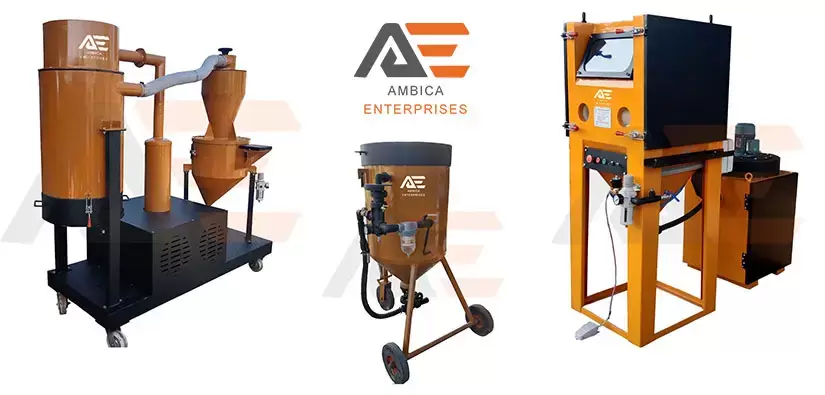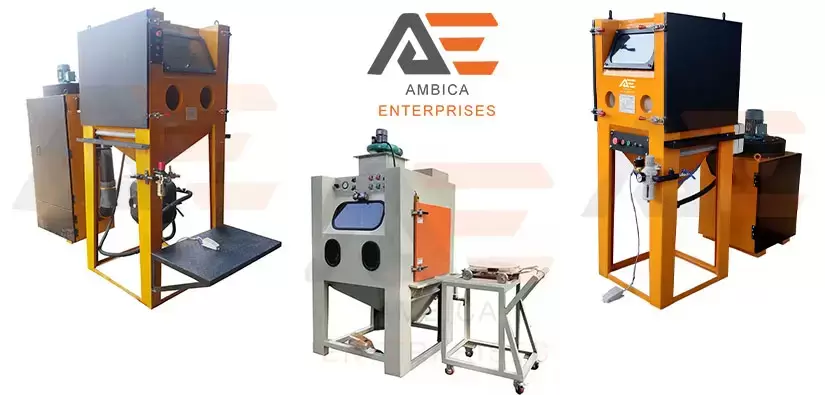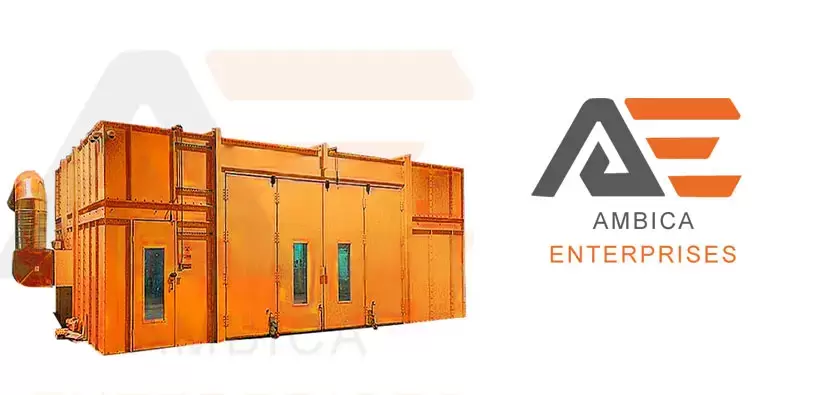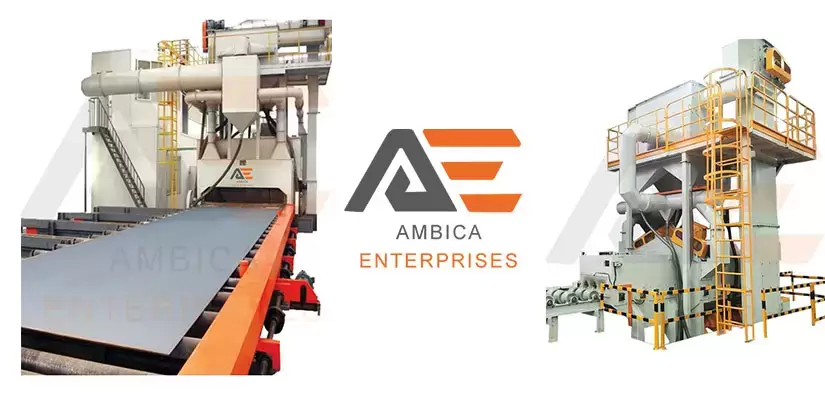
Sand blasting machines are indispensable tools used across various industries when it comes to surface preparation. These machines, designed to propel abrasive materials at high velocities, have revolutionized the way we clean, restore, and etch surfaces. Manufacturers like us offer a wide range of sand blasting machines to cater to diverse surface preparation needs. We will explore the various types of sand blasting machines available and their specific applications.
In the world of surface preparation and cleaning, Sand Blasting Machines play a vital role. They are versatile tools used across various tasks like removing rust, paint, and contaminants from surfaces. To fully understand their functionality, it’s important to explore the various types of sand blasting machines available.
Types of Sand Blasting Machines
We manufacture all types of sand blasting machines to fulfill the various requirements of surface preparations. Here are some of our blasting machines:
- Portable Sand Blasting Machine: Portable sand blasting machine is highly versatile and offer exceptional mobility, making them ideal for a range of applications. They come in various models, including the P7-150, P7-300, P7-500, and P7-1000. Let us now look at the specific applications for these machines:
- P7-150: This lightweight and easy-to-maneuver machine also called a mini sand blaster or portable sand blaster is perfect for smaller-scale projects, such as the removal of graffiti, paint, and rust from various surfaces. What sets it apart is its 150 kg metallic abrasive tank capacity, which allows for extended use without frequent refills. Whether you’re working on automotive parts, outdoor structures, or delicate materials like wood and glass, the P7-150 provides the flexibility and power you need to achieve remarkable results.
- P7-300:With a bit more power, the P7-300 is suitable for medium-sized projects that demand a higher abrasive capacity. Sporting a 300 kg metallic abrasive tank, this machine can handle more extensive surface preparation tasks. It’s commonly used in the construction industry for cleaning and restoring structures, preparing surfaces for coatings, and even refurbishing stone and marble. The increased capacity translates to fewer interruptions, enhancing efficiency and productivity.
- P7-500: The P7-500 represents a significant step up in capacity and power. With a 500 kg metallic abrasive tank, it’s designed for tasks that require extra strength and efficiency. Industries that demand high-rate sandblasting, such as shipyards, manufacturing, and heavy equipment maintenance, find the P7-500 to be an invaluable tool. This machine is capable of tackling substantial components and projects with ease. Whether you’re removing rust from marine vessels, preparing large equipment for coatings, or handling any surface that demands high-performance cleaning, the P7-500 is the go-to choice.
- P7-1000: For those dealing with substantial components and extensive projects, the P7-1000 offers unparalleled performance. Its massive 1000 kg metallic abrasive tank capacity, coupled with a 50 HP air compressor, ensures that no task is too large. This machine is ideal for the most demanding industries, including heavy manufacturing and construction. It’s used to prepare massive equipment, such as bulldozers and cranes, for surface coatings and restoration. The P7-1000 is a game-changer for those who require thorough and efficient surface preparation on a grand scale.
These portable sand blasting machines are known for their user-friendly design, making them accessible to operators with varying levels of experience. Whether you’re a professional or a do-it-yourself enthusiast, the P7-150 and P7-300 offer the perfect balance of mobility and power to ensure that your projects are completed with precision and ease. Whether you’re in shipbuilding, manufacturing, or construction, the P7-500 and P7-1000 provide the power and efficiency required to handle large-scale projects.
- Sand Blasting Cabinet: Sand blasting cabinets create a controlled environment where the operator works inside the enclosure while manipulating the blasting nozzle through gloves attached to the cabinet. The abrasive material is propelled onto the workpiece, and the enclosed space contains the abrasive and dust. Manufacturing sand blasting cabinet involves constructing an enclosed space with gloves, viewing windows, and access points. The cabinet’s structure is made from durable materials, often steel, with proper ventilation and filtration systems to control dust. Provide three types of sand blasting cabinets:
- Pressure Blasting Cabinet: Pressure blasting cabinets are a step up in precision and containment. They operate similarly to standard cabinets but with a significant difference – the addition of a pressurized vessel that stores abrasive material. When the operator activates the blasting nozzle, the pressure is released, propelling the abrasive onto the workpiece. This pressurized approach ensures precise and powerful blasting, making it ideal for applications demanding accuracy and control. They are used to remove old paint, rust, and contaminants from delicate car parts without causing any damage. Metalworkers rely on a pressure blasting cabinet to remove scale, rust, and paint from metal surfaces before welding and painting. These cabinets are ideal for preparing metal structures or automotive components, ensuring that high-quality results are consistently achieved.
- Suction Blasting Cabinet: Suction blasting cabinets, in contrast to pressure cabinets, employ a vacuum system to draw abrasive material into the blasting gun. The operator manipulates the nozzle to control the abrasive stream, while the machine’s vacuum system ensures that the abrasive is efficiently and safely collected. These cabinets are ideal for personalized woodworking projects and adding decorative elements to furniture. Jewelry designers employ these cabinets to engrave and etch intricate details on precious metals and gemstones. Suction blasting cabinet is suitable for working on delicate or fragile surfaces that could be damaged by the force of pressure cabinets. They provide a gentler but still effective method for surface preparation.
- Wet Blasting Cabinet: Wet blasting cabinet uses water to suppress dust and control heat during the blasting process. Water is mixed with abrasive material to create a slurry, which is then propelled onto the workpiece. The introduction of water not only minimizes dust but also helps cool the process, making it suitable for heat-sensitive materials. Shipyards utilize wet blasting cabinets to remove rust and marine growth from ship hulls and equipment while minimizing environmental impact. Wet blasting is suitable for surfaces that are sensitive to heat or abrasive damage. It is a gentler method that preserves the integrity of materials while achieving effective surface preparation.

- Sand Blasting Room: Sand blasting rooms provide a large, enclosed space for extensive sand blasting operations. Operators work within this room, using abrasive material propelled by compressed air onto workpieces placed on a turntable or moved by conveyor systems. The controlled environment allows for thorough and efficient surface preparation. Sand blasting rooms are used in manufacturing plants for the surface preparation of large machinery, such as bulldozers and construction equipment. They provide a controlled environment for consistent and thorough surface cleaning. They are indispensable in the automotive and aerospace industries for preparing vehicle bodies, aircraft components, and other large structures.
- Dustless Sand Blasting Machine: Dustless or Vacuum blasting machine is specialized tools designed for efficient and eco-friendly surface preparation. These machines use a unique process that combines abrasive blasting with simultaneous dust and debris recovery. A vacuum system creates a controlled environment in which abrasive material is propelled onto the workpiece while simultaneously drawing in dust and spent abrasive, ensuring a clean and contained operation. Vacuum blasting is considered an eco-friendly alternative to traditional abrasive blasting methods. The dust and spent abrasive are collected and contained, reducing the release of contaminants into the environment. This makes vacuum blasting suitable for projects in environmentally sensitive areas.

- Automatic Sand Blasting Machine: Automatic sand blasting machines are cutting-edge tools designed for precise and consistent surface preparation. They are automated devices programmed to carry out abrasive blasting tasks with high accuracy and repeatability. These machines ensure that each blasting cycle is uniform, making them ideal for industries with high production volumes. Glass manufacturers employ these machines to create complex patterns and designs on glass surfaces. The automated process ensures the reproducibility of patterns and designs, making it a valuable tool for the glass industry.

- Airless Sand Blasting Machine: Airless sand blasting machines represent a sophisticated and efficient approach to surface preparation. Unlike traditional methods that rely on compressed air, these machines employ a high-speed blasting wheel or turbine to accelerate and propel abrasive media onto the workpiece. This innovative design offers several distinct advantages. Airless sand blasting machines stand as a testament to innovative engineering in the realm of surface preparation. Their utilization of blasting wheels, precision engineering, and efficiency make them a valuable asset in industries where consistent and powerful surface cleaning or coating removal is required.
Requirements For Sand Blasting Machine
- Abrasive Material: The choice of abrasive material depends on the surface and the level of cleaning required. Common options include sand, aluminum oxide, steel shots, and steel grits. The selection of the right abrasive material is crucial for achieving the desired results without damaging the surface.
- Abrasive Flow Rate: The rate at which abrasive material flows through the machine significantly impacts the efficiency of the blasting process. It’s crucial to select a machine with an appropriate flow rate, as too little or too much can affect the quality of the surface preparation.
- Nozzle Size: The size of the blasting nozzle affects the precision and coverage of the blasting. Different nozzles are suitable for various applications. Choosing the right nozzle size ensures that the abrasive material is directed accurately and efficiently, resulting in a more controlled and effective process.
- Compressor Power: The compressor’s power determines the velocity of the abrasive material. More powerful compressors are needed for larger and more challenging tasks. The choice of compressor power should align with the size and scope of the project, ensuring that the machine can deliver the required force for the specific job at hand.
Applications of Sand Blasting Machine
- Automotive Industry: Sand blasting is widely used in the automotive industry for various applications. It is employed for vehicle restoration, including paint removal and surface cleaning. The precise and efficient nature of sand blasting makes it an indispensable tool in the automotive sector. This process ensures that old paint, rust, and contaminants are removed, providing a clean surface for further repairs or refinishing.
- Construction Sector: In the construction sector, sand blasting is utilized to clean surfaces, remove coatings, and prepare materials for painting or welding. It is particularly valuable in preparing surfaces for various construction tasks, ensuring the quality of work. Whether it’s removing old paint from structural steel or cleaning concrete surfaces before application, sand blasting plays a critical role in maintaining the integrity and appearance of construction materials.
- Marine and Shipbuilding: Shipyards rely on sand blasting for cleaning, maintenance, and the preparation of surfaces on vessels. The removal of rust, old paint, and contaminants is crucial in maintaining the integrity of ships and ensuring their longevity. Sand blasting is an essential step in the maintenance and refurbishment of marine vessels, preventing corrosion and extending the lifespan of these valuable assets.
- Art Restoration: Delicate art restoration often involves sand blasting to clean and restore sculptures and monuments. The precision and control offered by sand blasting machines are vital in preserving the artistic and historical significance of these works. By gently removing contaminants and restoring the original texture and appearance of artworks, sand blasting ensures that art pieces maintain their aesthetic and historical value.
Advantages of Sand Blasting Machine
Sand blasting Machine offers several advantages across industries, including:
- Efficient Removal: Sand blasting machines efficiently remove old paint, rust, contaminants, and unwanted coatings from surfaces, ensuring a clean and smooth finish.
- Surface Preservation: It extends the life of metal structures and surfaces by eliminating rust and preventing corrosion, enhancing the longevity of materials.
- Precise Cleaning: Sand blasting reaches even hard-to-reach corners, ensuring a thorough cleaning process. It is invaluable for achieving high-quality results in surface preparation.
- Surface Preparation: It is a critical step in preparing surfaces for subsequent treatments, such as painting, welding, or coating, ensuring that these processes adhere effectively.
- Time Savings: Sand blasting significantly reduces the time required for cleaning and surface preparation compared to manual methods, improving overall productivity.
- Non-Complex Process: It utilizes a straightforward and non-complex process, making it accessible to a wide range of users, from professionals to enthusiasts.
Safety Measures and Precautions
Personal Protective Equipment (PPE): Using Sand Blasting Machines involves certain risks. Personal Protective Equipment (PPE) such as goggles, respirators, and protective clothing such as sand blasting helmets and safety wear suits is crucial to protect workers from airborne abrasives and dust.
Worksite Ventilation: Proper ventilation at the worksite is essential to disperse dust and maintain air quality. Dust collectors and exhaust systems are commonly used to minimize exposure to harmful particles.
Training and Certification: Operators should receive adequate training and certification to handle Sand Blasting Machines safely. Proper training ensures that workers understand the equipment, its limitations, and the necessary safety procedures.
Working Of Sand Blasting Machine
Sand blasting machines are essential tools for surface preparation and restoration, but understanding how they work and how they are manufactured can provide valuable insights into their effectiveness and quality.
The fundamental principle behind sandblasting is the projection of abrasive material at high velocities onto a surface to remove contaminants, paint, rust, or other unwanted layers. The basic components of a sand blasting machine include:
- Abrasive Material: This is usually sand, aluminum oxide, glass beads, or other abrasive materials. It is loaded into the machine’s tank.
- Air Compressor: The machine uses compressed air to propel the abrasive material. The compressor generates the high-pressure air needed for the process.
- Blasting Nozzle: The abrasive material is forced through a blasting nozzle at high speeds. The nozzle’s design and aperture size determine the velocity and pattern of the abrasive stream.
- Control System: Operators can control the pressure, flow rate, and direction of the abrasive stream through the control system.
The process begins with the loading of abrasive material into the machine’s tank. The air compressor generates compressed air, which is then mixed with the abrasive material. The resulting mixture is propelled through the blasting nozzle and directed towards the surface to be treated. The high-speed impact of abrasive particles effectively removes unwanted coatings and contaminants.
The operator’s skill and experience play a crucial role in achieving the desired results. They control the nozzle’s position, distance from the surface, and the duration of blasting to ensure uniform and precise surface preparation.
Manufacturing Process of Sand Blasting Machine
The manufacturing of sand blasting machines involves several key steps:
- Design and Planning: We start by designing the machine based on the intended application and capacity. They consider factors such as the type of abrasive material, tank capacity, compressor power, and control system.
- Sourcing Materials: High-quality materials are crucial for durability and performance. Manufacturers source materials such as mild steel for the machine’s body, blasting hoses, sand blasting nozzle, dust collector, and control systems.
- Fabrication: The machine’s body is fabricated using the chosen materials. This includes the construction of the tank, housing for the air compressor, and mounting for the blasting nozzle.
- Assembly: All components are assembled, including the air compressor, control system, dust collector, blasting nozzle, and hoses.
- Quality Control: Each machine undergoes rigorous quality control checks to ensure that it meets safety and performance standards. This includes testing the control system, checking for leaks, and verifying the compressor’s efficiency.
- Painting and Finishing: The machine is often painted to protect it from corrosion and improve its appearance.
- Packaging and Distribution: Once a sand blasting machine passes quality control checks, it is packaged and prepared for distribution to customers.
Ambica Enterprises, as a leading sand blasting machine manufacturer in India, we often produce different models of sand blasting machines to cater to various industries and applications. These models vary in terms of capacity, power, and design to meet specific needs. High-quality manufacturing ensures that these machines are reliable, durable, and efficient in their operation. We provide all of these blasting machines at the most affordable price in India.
